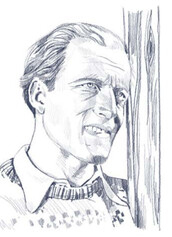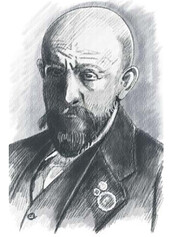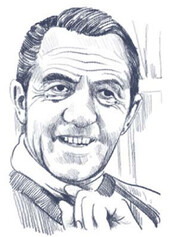Ski tracks all over the world
The dashing ski pioneers from the Arlberg shaped the history of skiing.
Houses with names like “Kandahar”, “St. Anton” and “Hannes Schneider” are not only to be found in the Arlberg region, but also in Nozawa Onsen, the Japanese twintown of St. Anton am Arlberg. The Austrian ski sport pioneers left their very elegant tracks all around the world, especially in America and Japan.
Arlberg ski pioneer, Hannes Schneider (1899-1955) is still revered in Nozawa Onsen, the famous ski resort in Nagano. At the invitation of the Japanese crown prince, Schneider came to Japan in 1930, where he explained the revolutionary Arlberg ski technique in seminars and on the slopes. This new skiing technique, of which he played a large part in developing, had previously caused quite a furore in his homeland. The young lad had burst onto the scene with his new stem turns, rather than traversing the slopes in customary Telemark style. He was determined to make downhill runs more dynamic and enjoyable. And succeeded, but it took courage to change old patterns, in this case traditional slanted runs, and invent the forerunner of the parallel turn.
Ski Instructor at Ski-Club Arlberg
Born in Stuben am Arlberg, Johann, or rather “Hannes” Schneider was a bold and assertive young lad. Attributes necessary to make such a lasting impression on the development of modern ski sport, together with Fridtjof Nansen from Norway and Sir Arnold Lunn from England. His enormous talent provided the basis for his career. He demonstrated this for the first time in 1903 aged twelve, at the first intern races of “Ski-Club Arlberg“, which was founded on 3rd January 1901.
His success soon brought him wide recognition, which was followed by an invitation to work as a ski instructor in Les Avants in Switzerland. He chose, however, to make his homeland the focus of his life and work for the time being. Schneider worked as a “Ski-Club Arlberg“ ski instructor for the Hotel Post and founded the world’s first ski school in the winter season of 1920/21. His ambitions, however, went far beyond the realm of ski instruction.

Together with Sir Arnold Lunn, a British ski racer, mountaineer, writer and co-founder of the Swiss “Kandahar Ski Club“, he established the Arlberg-Kandahar Race extern, thereby laying the foundations for today’s alpine ski racing.
Hannes Schneider also gained fame as ski star and actor in legendary ski and feature films, such as Arnold Flack’s mountain movies, “Der weiße Rausch – Neue Wunder des Schneeschuhs“ (with Leni Riefenstahl in the leading female role). Works that caused international furore with sensational imagery of the alpine landscapes and ski sport. These images of spectacular downhill runs contributed essentially to Arlberg’s reputation as the cradle of alpine skiing across the world.
The fact that Hannes Schneider preferred to take a direct route, not only when skiing, proved ultimately to be his downfall. Because he refused to tolerate illegal Nazis in his ski school and was a business partner and friend of Jewish Rudolf Gomperz, he was forced to leave Austria under National Socialist regime. He emigrated to the east coast of America, where Schneider set about building a comprehensive ski infrastructure with slopes and lifts in North Conway, New Hampshire. His ski school students were divided into different groups according to ability. A teaching method that Schneider had already introduced at the Arlberg, and one that brought him great recognition. The ”Hannes Schneider Ski School“ quickly built up a great reputation in the USA, ”Hannes Schneider“ and the ”Arlberg“ became both legend and trademark.
Ski Racer and Instructor, Rudi Matt
Hannes Schneider managed Skischule Arlberg together with St. Anton man, Rudolph ”Rudi“ Matt (1909–1993), who took over ski school operations when Schneider moved to America. Matt was a brilliant mountain filmmaker, photographer and equally daring and talented skier as Schneider. He successfully participated in Nordic competitions such as ski jumping and cross-country skiing, and became world champion in slalom in 1936. Like many other Arlberg ski instructors of that time, he followed the call to move overseas, where the Arlberg technique was very popular. In the winter of 1950/51, Matt managed the ski school in Sun Valley in the State of Idaho, in the late 1950s he made several trips to Japan to demonstrate the popular mode of ski instruction. In 1968, he was involved with the construction of a ski resort in the Indian Kashmir region. His performances as an actor will also go down in history. He played the leader of a foxhunt on skis in the film, “Der weiße Rausch – The White Thrill“.

Tourism and cable railway pioneer, Rudolf Gomperz

The fate of one of Hannes Schneider’s faithful companions and mentors could never be turned into an entertaining film. Tyrolean playwright, Felix Mitterer, made this tragedy the subject of a play in “Kein schöner Land – No Country More Beautiful“: Jewish engineer, tourism and cable railway pioneer, Rudolf Gomperz (1870–1942) moved from Vienna to St. Anton in 1905 and took over presidency of “Ski-Club Arlberg“ in 1906. He became chairperson of the Austrian Ski Association (ÖSV) in 1908. In 1910, he took over the helm of the Central European Ski Federation, but remained Managing Director of the Austrian Ski Federation. He worked tirelessly for the interests of ski sport and was instrumental in procuring donations to invest in St. Anton’s infrastructure, such as the first ski jump, ice-skating rink, toboggan run and Galzigbahn cable car. Gomperz did not live to see Hannes Schneider’s incredible international success. The Nazis banned him from working and sent him back to Vienna, where he had to wait for deportation. In 1942, he was murdered in Maly Trostinec extermination camp near Minsk in Belarus. Without his patron and supporter Rudolf Gomperz, Hannes Schneider would probably not have been able to enjoy such a successful career. The Arlberg and its people owe a great deal to Gomperz.
Champagne snow for Friedl Pfeifer
Schneider student and successful skier, Friedl Pfeifer (1911–1995), who won the Kandahar Race extern and Hahnenkamm Race, amongst others, was an important ambassador for Austrian ski sport. The mountain farmer’s boy and ski instructor from St. Anton emigrated to the United States in 1938, where he was the driving force behind setting up a glamorous ski resort in an abandoned silver mine in the Rocky Mountains around Aspen, Colorado, thereby heavily boosting the popularity of skiing throughout the USA. The mountain there reminded Pfeifer of the Arlberg. He named it “Buttermilk-Mountain“, because the snow appeared to be as soft as butter and as permeable as milk and is still referred to as powder and “champagne snow”. Combined with his ability, commitment and communication skills, Friedl Pfeifer’s downhill runs were as speedy as his unerring success, which catapulted him to the upper echelons of American high society.
